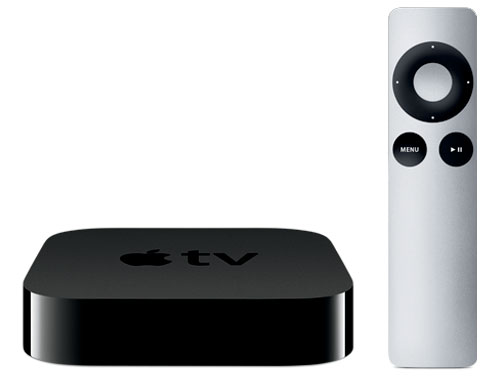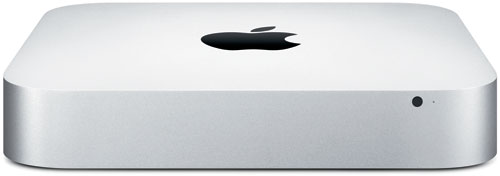Hosted by site sponsor WebMate.
Apple TV Q&A
Published April 13, 2012
Also see: All Apple Q&As >> Apple TV Q&A (Home)
To be notified of new Q&As, sign up for EveryMac.com's bimonthly email list.
What are the differences between the black Apple TV 3rd Gen and the Aluminum Mac mini available at the time of its introduction?
Please note that the Apple TV 3rd Gen and the Aluminum Mac mini mentioned in this Q&A both have been discontinued, but this Q&A is useful for anyone considering either model on the used market.
When EveryMac.com compared the previous Apple TV model -- the Apple TV 2nd Gen -- and the Aluminum Mac mini models available at the time it was released, one difference -- the Mac mini's optical drive -- was immediately obvious.
For the "Mid-2011" Mac mini models available at the time the Apple TV 3rd Gen was introduced -- the entry-level is the Mac mini "Core i5" 2.3 (Mid-2011), specifically -- Apple dropped the optical drive, but the differences between the Apple TV 3rd Gen and the "Mid-2011" Mac mini line are no less significant.
Functionality Differences
In general, the Apple TV 3rd Gen makes it simple to stream content from a Mac, PC, iPod, iPhone, or iPad to a HDMI-equipped HDTV and pay for movies and television shows from Apple. It also makes it simple to stream online content from Netflix, YouTube, Flickr and other sources.
The "Mid-2011" aluminum Mac mini models, on the other hand, are full fledged computers and are capable of performing a variety of tasks that any other entry-level Mac can perform. Not only is it easy to connect these Mac mini models to an HDMI-equipped HDTV, it also is easy to listen to music with iTunes, surf the Internet, write documents, create websites, organize photos, play games, and more.
The aluminum Mac mini models also can store content on a large standard 500 GB hard drive, whereas the Apple TV only has 8 GB of flash storage to cache streamed content. The Apple TV can store content remotely using Apple's iCloud functionality, but so can the Mac mini.
Those interested in a brief answer can stop reading and make a decision based on the above. However, because both models are easy to connect to a television -- and there are so many differences -- an in-depth comparison also can be useful for all the differences.
External Differences
Externally, the black 3rd Gen Apple TV is quite different from the aluminum Mac mini. The Apple TV is housed in a truly tiny 3.9 inch by 3.9 inch by 0.9 inch case in black that resembles a hockey puck and ships with an aluminum Apple Remote.

Photo Credit: Apple, Inc. (2nd and 3rd Gen Apple TV)
The "Mid-2011" aluminum Mac mini, by contrast, uses a relatively large 7.7 inch by 7.7 inch by 1.4 inch aluminum case. It does not ship with a remote by default, but it does support one and the same aluminum Apple Remote can be added as a US$19 option.

Photo Credit: Apple, Inc. ("Mid-2011" Aluminum Mac mini)
Connectivity Differences
Connectivity is different as well as external design. Both models have an HDMI port and support optical audio out and 802.11a/b/g/n wireless networking. However, the aluminum Mac mini models also have a "Thunderbolt" port, a "Gigabit" Ethernet port, a Firewire "800" port, four USB 2.0 ports, support for analog audio out as well as optical/analog audio in and Bluetooth 4.0 in addition to an SDXC capable SD card slot.
The Apple TV does, however, have a lesser 10/100Base-T Ethernet port and a Micro-USB port "for service and diagnostics." Power consumption is considerably different as well, as the the Apple TV only uses 6 watts whereas the aluminum Mac mini uses 85 watts.
Identification Differences
Visual differentiation between these two models is simple based on material, color and size. However, it can be a challenge to identify each from other Apple TV and Mac mini models.
Externally, the 3rd Gen Apple TV can be identified by model number A1427 on the bottom. The "Mid-2011" aluminum Mac mini models share model number A1347 with other Mac mini models, but they do share a unique 2442 EMC Number -- visible upon removing the bottom "spin off" panel -- and EveryMac.com methodically has documented this detail accordingly.
EveryMac.com's Ultimate Mac Lookup feature also can identify the "Mid-2011" Mac mini and 3rd Gen Apple TV models by their Serial Numbers.
Internal Differences
Internally, the differences between models are perhaps even more substantial than the external differences.
Apple only officially reveals that the 3rd Gen Apple TV has an Apple A5 processor, but as first noted by a curious member of the XBMC forums, it has a 1 GHz clockspeed, 512 MB of onboard RAM and 8 MB of flash RAM to buffer streaming.
The entry-level "Mid-2011" aluminum Mac mini model is powered by a 2.3 GHz Intel "Core i5 " (2415M) processor, an Intel HD Graphics 3000 graphics processor that shares 288 MB of RAM with the system, support for an unofficial maximum RAM of 16 GB, and a 500 GB hard drive for internal storage. The "Mid-2011" Mac mini models do not have an optical drive, so fans of DVDs would have to purchase an external drive (or buy a different Mac).
Software Differences
The operating system used by each model is completely different. The Apple TV runs a variant of the iOS that powers the iPod touch, iPhone, and iPad models, but it does not formally run the iOS nor can it run iOS applications either.
The "Mid-2011" aluminum Mac mini models run the full version of Mac OS X 10.7 "Lion" (and higher) and can run all Mac OS X applications that are compatible with this version of the operating system including applications that can record television with additional hardware.
Comparison Chart
These differences -- as well as additional configuration differences -- are summarized below:
 3rd Gen Apple TV |
 Mid-2011 Mac mini |
|
|---|---|---|
| Processor Type: | Apple A5 | Core i5 (2415M) |
| Processor Speed: | 1 GHz | 2.3 GHz |
| Standard RAM: | 512 MB | 2 GB |
| Standard VRAM: | Integrated | 288 MB† |
| Video Type: | Integrated | HD Graphics 3000 |
| Hard Drive: | None | 500 MB |
| Flash Memory: | 8 GB* | None |
| Optical Drive: | None | None |
| USB Ports: | 1 (Micro-USB) | 4 (2.0) |
| Firewire Ports: | None | 1 (800) |
| Display Ports: | HDMI | HDMI, Thunderbolt |
| Audio Ports: | Optical | Optical, Analog |
| SD Card: | No | Yes (SDXC) |
| Ethernet Support: | 10/100Base-T | Gigabit |
| AirPort Support: | 802.11a/b/g/n | 802.11a/b/g/n |
| Bluetooth Support: | No | 4.0 |
| OS Support: | iOS Derived | Mac OS X 10.7 |
| Video Support: | 1080p | 1080p |
| Local Content: | No | Yes |
| Recording Capability: | No | Yes (3rd Party Software) |
| Dimensions (In): | 3.9" x 3.9" x 0.9" | 7.7" x 7.7" x 1.4" |
| Power Consumption: | 6 Watts | 85 Watts |
| Remote Included: | Yes | No |
| Case Material: | Polycarbonate | Aluminum |
| Case Color: | Black | Silver |
| Apple Order No: | MC572LL/A | MC815LL/A |
| Apple Model No: | A1427 | A1347 |
| EMC No: | 2528 | 2242 |
| Original Price: | US$99 | US$599 |
* This Apple TV has 8 GB of flash RAM to act as a buffer during streaming. It is not designed for use as storage.
† The Intel HD Graphics 3000 graphics processor is "integrated" and shares a minimum of 288 MB of RAM with the system for video function.
So, which is best for my needs?
Ultimately, only you can decide if the 3rd Gen Apple TV or a "Mid-2011" aluminum Mac mini is best for your needs. If you need a simple and relatively inexpensive way to stream content from a Mac or PC (or your iPod touch, iPhone or iPad running iOS 4.2 or later) to your HDTV as well as stream Netflix, YouTube, Flickr and other content, and/or are interested in paying for content from Apple, the Apple TV could be ideal.
If you would prefer a full fledged "media center" to connect to your television -- complete with support for practically unlimited file formats (with third-party software), and the option of both buying content from Apple and recording television content, the ability to store content locally, and do everything else a Mac can do -- an aluminum Mac mini is a great choice provided that it is within your budget.
Permalink | Report an Error/Typo | Sign Up for Site Update Notices
Established in 1996, EveryMac.com has been created by experts with decades of experience with Apple hardware. EveryMac.com includes, and always has included, original research incorporating detailed, hands-on inspection of packaging, computers, and devices as well as extensive real-world use. All information is provided in good faith, but no website or person is perfect. Accordingly, EveryMac.com is provided "as is" without warranty of any kind whatsoever. EveryMac.com, and the authors thereof, shall not be held responsible or liable, under any circumstances, for any damages resulting from the use or inability to use the information within. For complete disclaimer and copyright information please read and understand the Terms of Use and the Privacy Policy before using EveryMac.com. Copying, scraping, or use of any content without expressed permission is not allowed, although links to any page are welcomed and appreciated.
